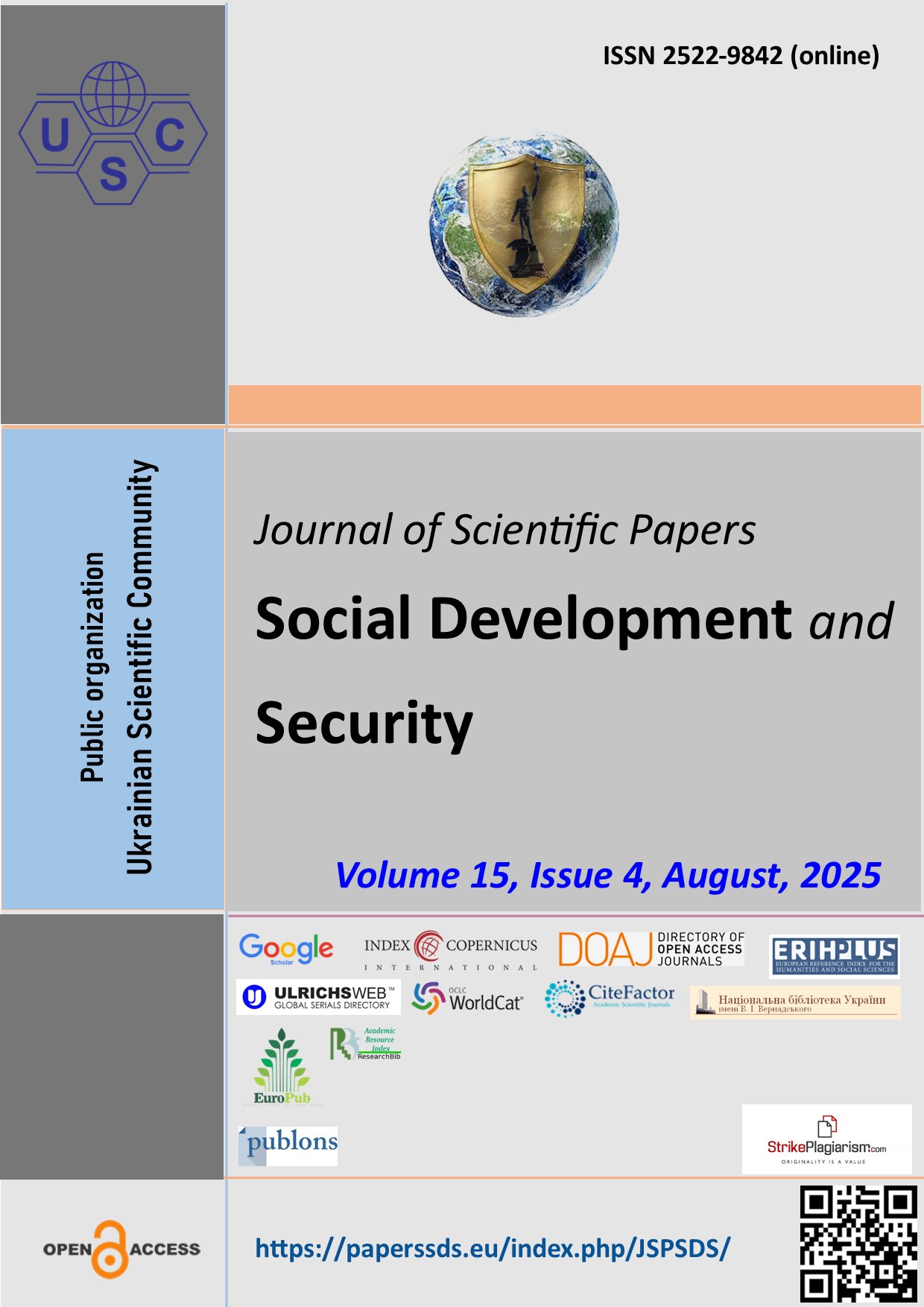Key Steps of Ukraine in the Military and National Security System to Increase Cognitive Resilience (2025-2028): Recommendations in the Cognitive and Military-Economic Spheres
Abstract
Purpose. Outline the key steps of Ukraine in 2025–2028 in the military and national security system, aimed at increasing the cognitive resilience of society and the defense sector, taking into account the threats of the Russian-Ukrainian war, global trends in information confrontation, and the economic challenges of the war.
Method. Methods of analysis and synthesis; comparison; strategic analysis.
Findings. Ukraine's key steps to increase cognitive resilience in 2025–2028 were identified under various scenarios of the development of the Russian-Ukrainian war; a system of military-economic consequences of cognitive influence was formed; a holistic description of Ukraine's key steps for 2025–2028 to increase its own cognitive resilience and, at the same time, a systematic, legitimate influence on the consciousness of Russians - citizens, elites and target groups..
Theoretical implications. The results of the study can be used by specialists of higher-level military command bodies to form views on further countering cognitive threats during an ongoing war.
Paper type. Theoretical.
Downloads
References
Deppe, A., & Schaal, K. (2024). Advancing towards a common understanding of cognitive warfare for science and technology, and identifying future research trajectories. NATO Science & Technology Board. Available from : https://pubmed.ncbi.nlm.nih.gov/39552633/
NATO Allied Command Transformation. (2024, July 3). ACT develops the Cognitive Warfare Concept to combat disinformation and defend against “cognitive warfare”. Available from : https://www.act.nato.int/article/cogwar-concept/
Helmus, T. C., & Holynska, K. (2024). Ukrainian resistance to Russian disinformation: Lessons for future conflict (Report No. RR-A2771-1). RAND Corporation. Available from : https://www.rand.org/pubs/research_reports/RRA2771-1.html
EEAS StratCom Task Forces. (2025). 3rd threat report: Fighting immunity to misinformation and disinformation (FIMI). European External Action Service. Available from : https://www.eeas.europa.eu/
IREX. (2024). Learn to discern in schools evaluation report. Available from : https://www.irex.org/sites/default/files/node/resource/evaluation-learn-to-discern-in-schools-ukraine.pdf
Mejova, Y., Capozzi, A., Monti, C., & De Francisci Morales, G. (2023). Narratives of war: Ukrainian memetic warfare on Twitter. arXiv. Available from : https://arxiv.org/abs/2309.08363
Gouliev, Z. (2025). Propaganda and information dissemination in the Russo-Ukrainian war: NLP of Russian and Western Twitter narratives. arXiv. https://arxiv.org/abs/2506.01807
NATO. (2020, May 20). Coronavirus: Invisible threats and preparing for resilience. NATO Review. Available from : https://www.nato.int/docu/review/articles/2020/05/20/coronavirus-invisible-threats-and-preparing-for-resilience/index.html
Freedman, L. (2021). NATO’s resilience: The first and last line of defence. LSE IDEAS. Available from : https://lseideas.medium.com/natos-resilience-the-first-and-last-line-of-defence-89c42ac47eb0
Conley, H. A., & Mina, J. (2022). The future of hybrid warfare. Center for Strategic and International Studies. Available from : https://www.csis.org/analysis/future-hybrid-warfare
Jastramskis, M., & Aleksejeva, I. (2023). Strategic communications, countering disinformation and propaganda: Recommendations for state policy. ResearchGate. Available from : https://www.researchgate.net/publication/383993797_Strategic_Communications_Countering_Disinformation_and_Propaganda_Recommendations_for_State_Policy
Baltic Centre for Media Excellence. (2022). Media literacy sector mapping in Estonia and Lithuania and the policy brief: With media literacy towards cognitive resilience. Available from : https://bcme.eu/en/our-work/research/report-media-literacy-sector-mapping-in-estonia-and-lithuania-and-the-policy-brief-with-media-literacy-towards-cognitive-resilience
Pullella, S. (2022). Inside Lithuania’s battle against Russian disinformation. TIME. Available from : https://time.com/6155060/lithuania-russia-fighting-disinformation-ukraine
Debunk.org. (2023). Debunk.org. In Wikipedia. Available from : https://en.wikipedia.org/wiki/Debunk.org
Pierri, F., Luceri, L., Jindal, N., & Ferrara, E. (2022). Propaganda and misinformation on Facebook and Twitter during the Russian invasion of Ukraine. arXiv. Available from : https://arxiv.org/abs/2212.00419
Boháček, M., & Farid, H. (2022). Protecting President Zelenskyy against deep fakes. arXiv. Available from : https://arxiv.org/abs/2206.12043
World Bank, Government of Ukraine, European Union, & United Nations. (2025). Ukraine fourth rapid damage and needs assessment (RDNA4), February 2022 – December 2024. World Bank. Available from : https://documents.worldbank.org/curated/en/099022025114040022
European Commission. (2024, October 30). Ukraine report 2024. DG NEAR. Available from : https://enlargement.ec.europa.eu/ukraine-report-2024_en
Norad Evaluation Department. (2024). Ukraine: Corruption risks and mitigation strategies (Report 3/2024). Norad. Available from : https://www.norad.no
NATO. (2019, March 20). Resilience: The first line of defence. NATO Review. Available from : https://www.nato.int/docu/review/articles/2019/03/20/resilience-the-first-line-of-defence/index.html
Abstract views: 157 PDF Downloads: 32
Copyright (c) 2025 Oleh Semenenko, Oleksandr Kin, Liliia Semenenko, Volodymyr Remez, Serhii Mytchenko, Dmytro Rybak

This work is licensed under a Creative Commons Attribution 4.0 International License.
The authors agree with the following conditions:
1. Authors retain copyright and grant the journal right of first publication (Download agreement) with the work simultaneously licensed under a Creative Commons Attribution License that allows others to share the work with an acknowledgment of the work's authorship and initial publication in this journal.
2. Authors have the right to complete individual additional agreements for the non-exclusive spreading of the journal’s published version of the work (for example, to post work in the electronic repository of the institution or to publish it as part of a monograph), with the reference to the first publication of the work in this journal.
3. Journal’s politics allows and encourages the placement on the Internet (for example, in the repositories of institutions, personal websites, SSRN, ResearchGate, MPRA, SSOAR, etc.) manuscript of the work by the authors, before and during the process of viewing it by this journal, because it can lead to a productive research discussion and positively affect the efficiency and dynamics of citing the published work (see The Effect of Open Access).
















